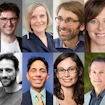On 21 October 2011, more than 100 investigators and clinicians who worked together on the Simons Simplex Collection gathered in New York City to celebrate their landmark achievement in autism research. Between 2006 and 2011, these teams — working out of 12 university clinics across the country and Canada — painstakingly amassed a wealth of high-quality genetic and phenotypic data, including biospecimens, from nearly 2,800 ‘simplex’ families.
“Hardworking scientists don’t celebrate their work enough,” says Gerald Fischbach, scientific director of the Simons Foundation, which funded the collection. “This coming together of people from around the country who worked on different aspects of the Simons Simplex Collection was a wonderful and well-deserved celebration. In my opinion, this group of clinicians, administrators, coordinators, consultants and molecular scientists has had an enormous impact on autism research that will last for years to come.”
The meeting had the atmosphere of a celebratory family reunion. Researchers who had worked on the Simons Simplex Collection at the same institution reminisced together about their efforts. Others relished the opportunity to attach a face to a coworker with whom they had had many hours and years of contact by email and phone.
At the meeting, investigators described recent analyses of the collection’s data, which has identified a host of new candidate mutations that may play a role in development of the disorder, representing a quantum leap forward in the study of the genetic mutations involved in autism. The researchers also gave talks about work in progress, and discussed ways of analyzing the data in the years to come as new technologies are developed. The talks made it clear that the collection is a gift to the autism research community that will keep on giving, offering researchers a platform on which to study autism spectrum disorders for many years.
Simons Foundation board members and co-founders Jim and Marilyn Simons each spoke at the conclusion of the meeting, expressing their hopes that the collection will spur dramatic advances in autism research.
The gathering for the large group photo gave attendees a visceral sense of just how many researchers, and how many hours of effort, went into this monumental project. And although all felt pride, it was tempered by humility; the immediate task is done, but the questions that the collection will help to address remain vast.



